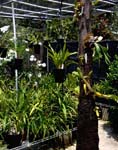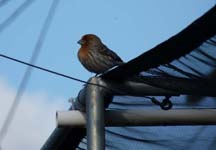Growing Areas |
Most of my growing area is under 60% shade cloth, which seems to give most of the orchids the dappled sun or open shade that they like. Cymbidiums and Laelia anceps and its close relatives need a bit more light, but even those do better with 45% shade cloth taking the "edge" off the noonday sun. Duration of light is a factor, and since my yard has an east-west orientation, in summer receives almost 14 hours of strong sunlight.My largest (and most dense) growing area is my patio. The back part is fairly shady, and is my best spot for Pleurothallis, Masdevallia, Dracula. This area also has a mist system that keeps the mounted plants (most of which also like a bit of shade) moist. Those are watered at least daily, two or three times a day on the hottest summer days. The hanging plants receive the best of the regular afternoon ocean breeze. Covering is 60% Aluminet© shade cloth. Aluminet is aluminized Mylar©. Along with reducing the light, it also reflects heat. |
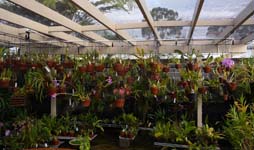 |
Warm-growing Orchids Without a Greenhouse |
I now have the luxury of a small (8' x 12') greenhouse for the relatively small number of warm-growing orchids in my collection. For the first 10 years or so of my orchid hobby, I lived in a condo with only a small patio, so no place for a greenhouse. I converted my spare bedroom to a growing area for my Phalaenopsis and other warm-growing orchids. (Guests had to sleep on the sofa. I am not the only one with this problem...) The room received about 4 hours of good sunlight, not enough for blooming. Those plants did not need a lot of light intensity, but did need more duration. I solved that problem by utilizing fluorescent shop lights, supported on stands made of PVC pipe. I gave the plants 12 hours a day, and had a very good record for multiple-year reblooming of Phalaenopsis. Here is what it looked like. |
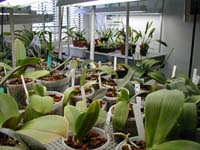 |
Vandas require more light than Phalaenopsis, and also have hanging roots that need frequent watering. During most of the year, they hung outside, but in winter needed some protection. I rigged a HID light over the shower of the spare bathroom, set up a sprinkler system with a 5-gallon bucket and a submersible pump, and kept the Vandas and wamer-growing Cattleya-group plants alive (if not terribly happy) through the cold months. |
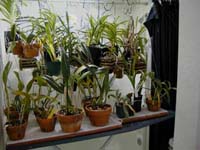 |
